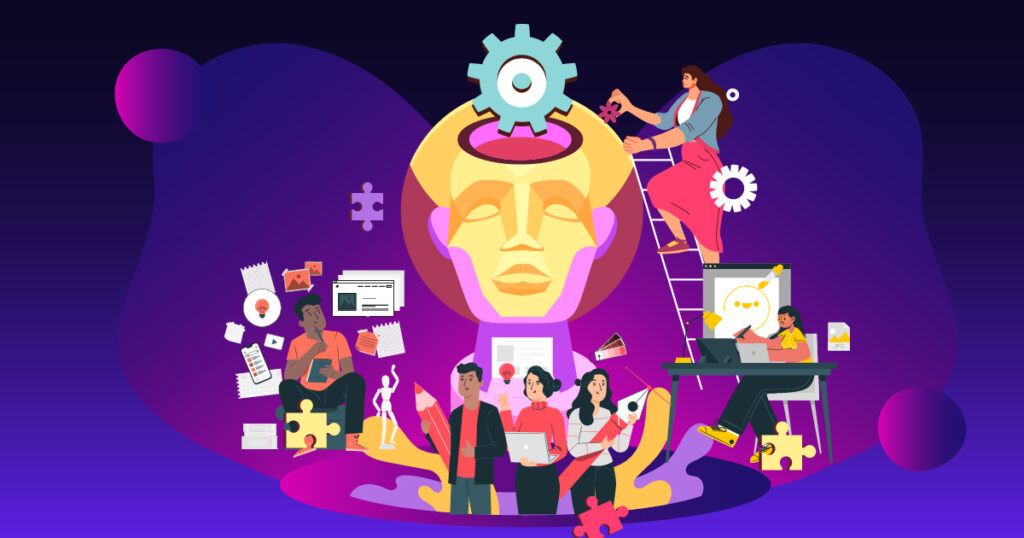
The best UX designers go beyond standard aesthetics and functionality. They explore where human behavior and design choices meet, and it’s not always easy to figure out. In this blog, we’ll explore the psychology of design and why understanding the human brain is key to creating compelling user experiences.

Brands can enhance:
- Digital ads: Emotive imagery, colors, and typography
- Websites: Layout, navigation, and visual elements
- Product packaging: Attention-grabbing design, benefit communication
- Mobile apps: User-friendly interface, intuitive design
- Social media graphics: Captivating visuals, engaging messaging
- Email newsletters: Compelling headlines, eye-catching visuals
- Physical retail environments: Store layout, signage, product placement
- Branding materials: Logo design, color palettes, typography
From the layout of a website to the color scheme of a mobile app, every design decision influences how users perceive and interact with your brand. At the heart of this process lies a myriad of psychological concepts that shape user experience (UX) and user interface (UI) design. Let’s look at some of the most influential UX principles and see how to apply them to your brand.
Gestalt Principles: Make it Cohesive
You can think of your design like a puzzle. Each element adds a piece to the whole picture. Gestalt Principles include concepts like proximity, similarity, and closure, and these help designers organize things better. This makes for a more visually cohesive and intuitive user experience. For example, designers often group related elements together or enhance navigation.
Proximity: When things are placed close together on a website or app, it communicates “these are related.” This helps businesses guide users to relevant information or actions.
Similarity: Do you use the same color or shape for certain elements throughout your interface? This creates continuity and gives visual clues that the elements are related.
Closure: Ever noticed how your brain automatically fills in the blanks in incomplete shapes or patterns? Brands can use this principle to prompt users to mentally complete actions or understand information, making the user experience more engaging and intuitive.
Hick’s Law: Eliminate Options
If you’ve ever felt overwhelmed by too many choices, you’re having a common experience. Especially in today’s world, psychology experts say that decision fatigue is a major problem modern humans face. Worst of all, it often leads people to procrastinate, avoid decisions, or make bad decisions simply because they don’t know what to do.
Hick’s Law suggests that the time it takes for a person to make a decision increases with the number of choices available. In design, this means you should simplify decision-making processes by reducing clutter and providing clear pathways for users. Whether it’s streamlining menu options or offering guided prompts, simplicity is the key to preventing decision fatigue.
Fitts’s Law
This design principle is easiest to understand – the bigger, the better. Fitt’s Law states that the time it takes to move to a target area is a function of the distance to the target and the size of the target. Ok that part sounds confusing, but it’s relatively simple. Designers leverage this concept by making interactive elements like buttons and
links larger and more accessible, especially on touch screens. By prioritizing ease of interaction, designers enhance user efficiency and satisfaction. If elements on a website are hard to see or read, that website automatically becomes less engaging.
Color Psychology
Colors can influence our emotions and perceptions both in real life and in the digital realm. Our writers at Penji have covered this topic extensively, so we’ll save you some time and just link to those guides here:
https://penji.co/meaning-of-brand-colors
https://penji.co/color-theory-in-graphic-design
https://penji.co/how-to-use-the-color-wheel
Maslow’s Hierarchy of Needs
You might wonder what this famous psych theory could possibly have to do with design. But if sales are your goal, you’ll consider Maslow’s hierarchy.
Beyond functionality, great design fulfills deeper human needs. Maslow’s pyramid outlines basic physiological requirements (needs) that must be met before higher-level desires are even thought about. Designers can apply this framework by ensuring that products and services meet users at every level. The way this is applied will depend on your unique brand and what it offers. But both practical needs (physiological) and emotional needs should be considered. It’s possible your brand can reach customers on an even higher level, speaking to their aspirational goals in life (self-actualization needs).
Physiological Needs: At this foundational level, a business might highlight how their products or services address customers’ immediate survival needs.
Safety Needs: Businesses can emphasize a sense of security and stability by offering reliable products, secure transactions, trustworthy customer service, or safe working environments.
Belonging Needs: A brand could emphasize how they are building communities, fostering relationships, and creating a sense of belonging through loyalty programs, social media engagement, or personalized customer interactions.
Esteem Needs: Recognizing and valuing customers’ contributions, achievements, and individuality through personalized experiences, rewards, and acknowledgment can help businesses fulfill a desire for recognition, respect, and self-esteem.
Self-Actualization Needs: Empowering customers to pursue personal growth, self-expression, and meaningful experiences can be a focus. Brands might highlight this through innovative products, creative platforms, or opportunities for self-improvement.
Cialdini’s Principles of Persuasion
Design isn’t just about guiding users or proving yourself trustworthy. It’s also about influencing user actions. Cialdini’s principles, including reciprocity, social proof, and scarcity, shed light on the psychological triggers that drive decision-making. By strategically incorporating these principles into design elements like testimonials, limited-time offers, and social sharing prompts, designers can nudge users towards desired behaviors.
The psychology of design is about peering into user behavior to see what really fosters positive brand experiences. By grasping these psychological frameworks, designers can captivate and engage their users on a deeper level. So, the next time you embark on any sort of design project, remember these principles.
Using the Psychology of Design to Improve UX

It’s no longer about what you offer, but how you offer it. Brands are increasingly using design psychology to elevate their UX in practical ways. From intuitive navigation to clear typography, every element is strategically crafted to ensure seamless interactions on digital platforms.
Penji’s seasoned design team can help you create a clear brand identity. With a deep understanding of design psychology, we help teams establish a stronger brand presence that leaves a lasting impact on audiences. Whether it’s revamping a logo or enhancing website layout, Penji’s expertise can get you over the hump from ‘just another brand’ to a memorable enterprise.
About the author

Brianna Johnson
Brianna is a professional writer of 10+ years who specializes in branding, marketing, and technology content.












